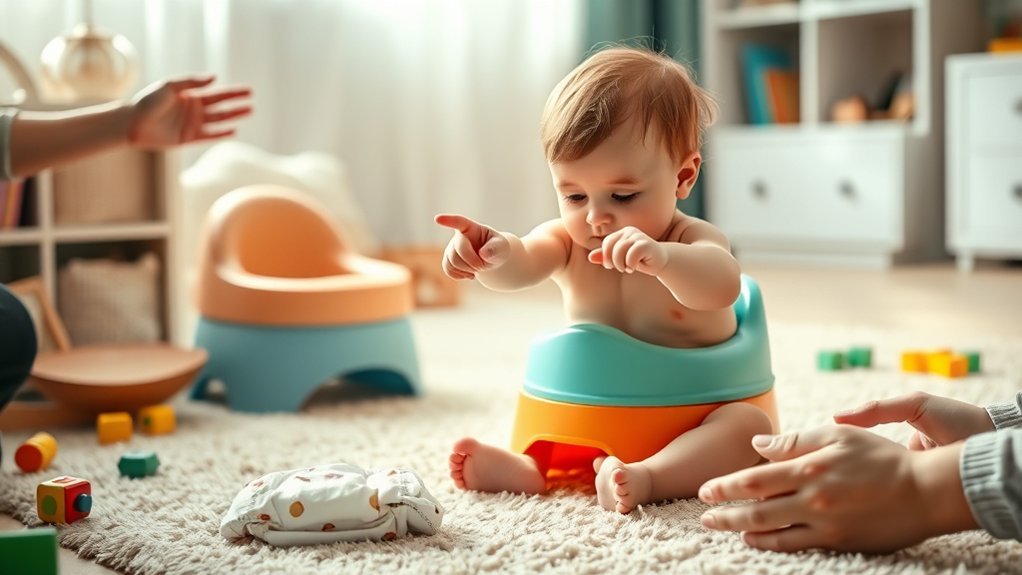Recognizing early potty signals can mean the difference between success and frustration. While some children may show signs of readiness, others might not be as quick to adapt. It’s essential to understand the do’s and don’ts of potty training to create a supportive environment. By focusing on encouraging awareness and avoiding pressure, you can foster a more positive experience. What strategies can you implement to guarantee your child’s confidence during this change?
Recognizing Common Early Potty Signals
Recognizing common early potty signals can greatly ease the potty training process for both you and your child. Early signs, such as squirming, crossing legs, or a sudden change in focus, often indicate that your child needs to go.
Parental observations play an important role in identifying these signals. By paying close attention, you can learn your child’s unique cues, allowing you to respond promptly.
Parental observations are key to recognizing your child’s unique potty cues, enabling timely and effective responses.
Timing is essential; intervene before accidents occur to reinforce their awareness. Acknowledge and validate their experiences, creating a supportive environment where they feel comfortable expressing their needs.
This proactive approach not only fosters independence but also strengthens the parent-child bond, empowering your child to embrace this essential developmental milestone.
Do’s: Encouraging Your Child’s Awareness
To effectively encourage your child’s awareness of their potty signals, it’s crucial to create a consistent routine around bathroom visits. Schedule regular trips to the toilet, reinforcing this habit.
Use potty rewards like stickers or small treats to positively reinforce their efforts, making the experience enjoyable. Incorporate awareness games that promote body awareness, such as singing songs about potty time or using fun visuals.
Engage your child by asking questions about how they feel before and after using the toilet, fostering communication about their bodily sensations.
These strategies not only enhance their recognition of potty signals but also empower them to take ownership of their bathroom habits, building confidence in this important developmental stage.
Don’ts: Avoiding Common Pitfalls
While encouraging your child’s awareness of potty signals, it’s important to avoid common pitfalls that can hinder their progress. One of the most significant common mistakes is pushing your child too hard or too fast. Rushing potty training can create anxiety and resistance, ultimately delaying success.
Additionally, avoid shaming or punishing your child for accidents; this can damage their confidence and willingness to communicate their needs.
Another common mistake is neglecting to recognize your child’s individual readiness signs, which can vary greatly.
Finally, don’t rely solely on rewards or punishments; fostering intrinsic motivation is essential for sustainable potty training.
Setting Up a Positive Potty Training Environment
Creating a positive potty training environment is essential for encouraging your child’s success and confidence. Incorporate potty training essentials and utilize positive reinforcement to create a supportive atmosphere. Here are some key elements to contemplate:
| Element | Purpose | Tips |
|---|---|---|
| Comfortable Toilet | Reduces anxiety | Use a child-sized seat |
| Consistent Schedule | Builds routine | Set regular potty times |
| Encouraging Words | Boosts confidence | Celebrate every effort |
| Positive Reinforcement | Motivates your child | Use stickers or rewards |
Fostering a nurturing environment will help your child feel secure and empowered during this important change. Remember, patience and encouragement are crucial in this journey.
Celebrating Progress and Milestones
Celebrating your child’s progress during potty training reinforces their achievements and motivates further success. Recognizing milestones, like using the potty independently or staying dry for a day, can greatly enhance your child’s confidence.
Implement milestone rewards, such as stickers or extra playtime, to create a positive reinforcement system. These rewards encourage your child to embrace each step of the process.
Additionally, progress tracking, whether through a chart or journal, allows you to visually document achievements, making the experience more tangible for your child. Regularly review these milestones together, fostering a sense of accomplishment and promoting motivation.
Frequently Asked Questions
What Age Should Potty Training Typically Begin?
Potty training typically begins between 18 to 24 months, but readiness signs vary. Look for cues like staying dry for longer periods, showing interest in the bathroom, or communicating discomfort with dirty diapers.
How Can I Tell if My Child Is Ready?
You can tell your child’s ready for potty training by observing potty readiness signs like staying dry for longer periods, showing interest in bathroom habits, and expressing discomfort with dirty diapers through specific child behavior cues.
What if My Child Resists Using the Potty?
If your child resists using the potty, it’s important to recognize potential potty anxiety and behavioral resistance. Encourage a relaxed atmosphere, offer positive reinforcement, and avoid pressure to foster confidence and reduce resistance effectively.
Should I Use Rewards During Potty Training?
Using rewards during potty training can enhance motivation. Implementing reward systems with positive reinforcement encourages your child’s progress, making them associate potty use with positive outcomes. Just guarantee rewards remain balanced to avoid dependency.
How Do I Handle Accidents During the Process?
Accidents happen; don’t stress. Focus on accident management by calmly addressing the situation. Use positive reinforcement to encourage progress, celebrating successes instead. This approach fosters confidence, helping your child embrace potty training with less anxiety.
Conclusion
As you begin this potty training journey, remember that every child is unique. By keenly observing early signals and fostering a supportive environment, you’re laying the groundwork for success. But beware of common pitfalls; they can derail your efforts unexpectedly. As you celebrate each small milestone, you’ll not only nurture your child’s confidence but also pave the way for newfound independence. Will your patience and persistence lead to a smooth change, or will challenges arise? Only time will tell.
